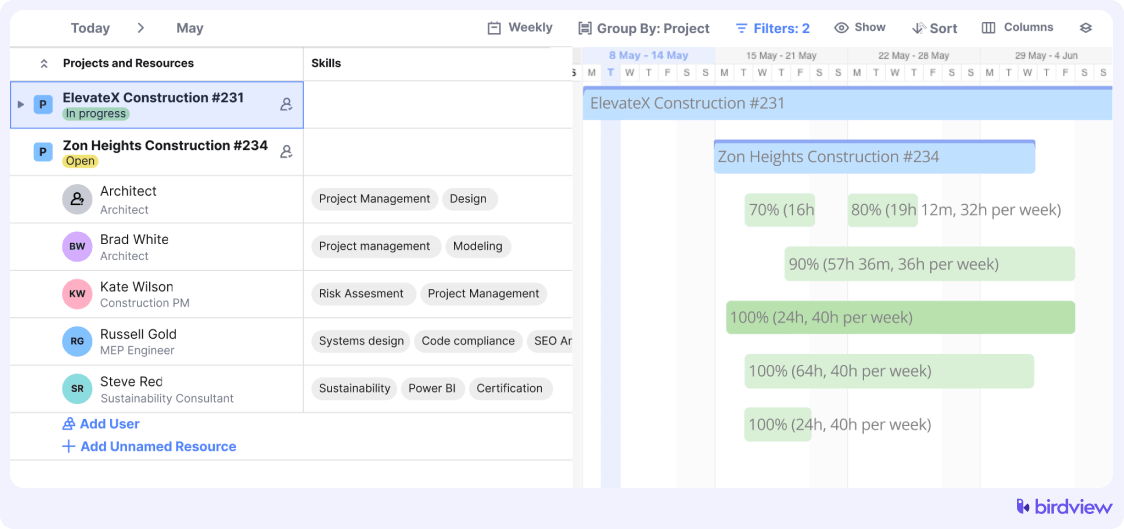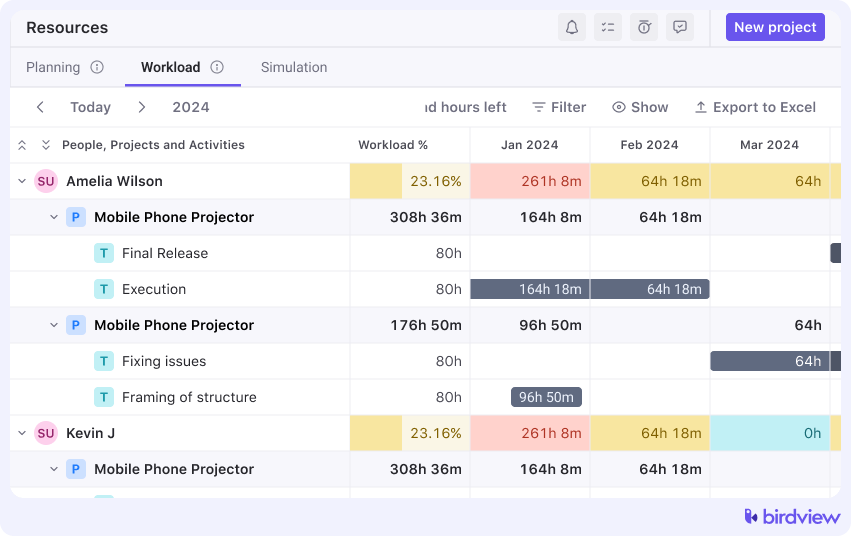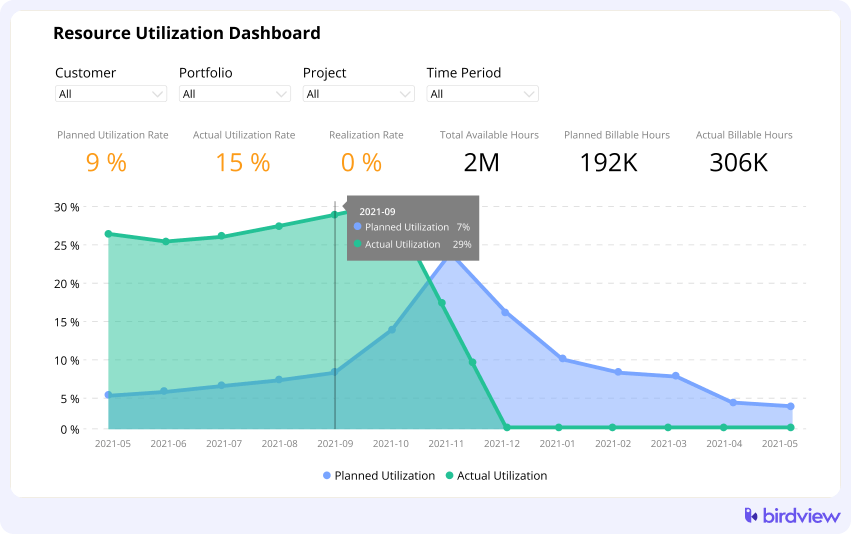Managing resources can be one of the trickiest parts of any project. Whether you’re struggling to allocate team members, running into budget overruns, or simply feeling overwhelmed by a lack of organization, resource challenges can derail even the best-laid plans. That‘s where a resource planning template comes in handy. It‘s like a roadmap for your resources, helping you track who, what, and how much you need to get the job done smoothly. With a solid resource plan in place, you can sidestep common pitfalls, ensuring your project runs on time and within budget.
What is a resource planning template?
A resource planning template is a tool designed to help you organize and allocate the resources needed for your project. Think of it as a central hub that brings together everything–people, tools, time, and budget–into one easy-to-read format. Instead of juggling scattered details, the template allows you to track what‘s needed at each stage of the project, from beginning to end.
For example, let‘s say you‘re leading a project that requires a graphic designer, a developer, and specific software. A resource planning template helps you figure out when you‘ll need those resources, how long you‘ll need them, and how to ensure you‘re not overspending on them. It‘s not just about knowing what you need–it‘s about knowing when and how to use it effectively.
Resource Utilization measures the percentage of time a resource is working on project-related tasks. Low utilization rates may indicate underutilization, while high utilization rates can result in burnout and reduced quality.
Key elements of a resource planning template
When building an effective resource planning template, it’s important to focus on key elements that ensure smooth project execution. Each element serves a specific purpose in helping you organize, allocate, and track the resources needed to complete your project on time and within budget. From identifying your resources to anticipating potential risks, every detail should be accounted for in your plan. Let‘s dive deeper into these essential components and why they are critical to project success.
Resource identification
The first step in any resource planning template is identifying all the resources required for your project. This includes people, equipment, tools, software, and even external resources like contractors or vendors. The more specific you can be, the better. Break down each resource by type (e.g., human resources, material resources) and role (e.g., designer, developer, photographer). You‘ll also want to include any relevant details, such as skills, availability, and contact information, to avoid confusion later. Clear identification ensures that nothing slips through the cracks and that everyone knows their role and responsibilities.

Example: If you‘re working on a website design project, list the project manager, UI/UX designer, developer, QA tester, and any software tools (like Adobe Creative Suite or a CMS) you‘ll need. Specify whether these resources are full-time, part-time, or available for a certain period.
Further Reading
Timeline and scheduling
Once you know what resources you need, the next step is to figure out when you need them. Proper scheduling ensures that resources are available at the right times and helps avoid bottlenecks that can delay the project. Create a detailed project timeline that breaks down tasks into phases and assign resources to each phase. Pay close attention to resource availability, as some team members or tools may only be available for limited periods. A well-planned schedule keeps the workflow smooth and reduces the risk of unexpected delays.

Example: For a marketing campaign, if your graphic designer is only available for the first two weeks, plan your content creation phase accordingly. Scheduling this phase later could mean missing deadlines due to resource unavailability.
Budget allocation
Budgeting is often one of the most challenging aspects of project management, and without careful planning, it‘s easy to overspend. A resource planning template helps you allocate and monitor your budget for each resource, ensuring you stay within financial constraints. This section should outline estimated costs for each resource, including salaries, equipment, and any outsourced services. Regularly tracking these expenses against the budget prevents costly surprises and helps make necessary adjustments early.
Example: For a product development project, you allocate $10,000 for software licenses, $50,000 for personnel salaries, and $20,000 for marketing. Tracking actual spending versus the budget allows you to adjust if costs exceed estimates in certain areas.
Capacity planning
Capacity planning is all about ensuring that your team isn‘t overwhelmed with too many tasks–or sitting idle with too few. By measuring each resource‘s workload, you can allocate tasks more efficiently, preventing burnout or underutilization. Your template should include the availability of each team member or tool, as well as their capacity to take on additional work. This way, you can balance workloads and redistribute tasks as needed. Monitoring capacity in real-time also helps you spot potential issues early and adjust before they affect the entire project.
Example: If one team member is handling 80% of the tasks and another is only assigned 20%, you may need to redistribute the workload to ensure even effort and prevent burnout.
Further Reading
Contingency planning
No matter how well you plan, unexpected issues will arise. That‘s why contingency planning is essential. This section of your resource planning template allows you to anticipate risks and plan for alternatives in case something goes wrong. This could involve having backup team members, alternative suppliers, or additional funds set aside for emergencies. Proactively planning for potential setbacks minimizes project disruptions and gives you the flexibility to adapt quickly.
Example: If your lead developer becomes unavailable halfway through the project, a contingency plan would identify a backup developer or outsourced agency that can step in to keep things moving forward.
Resource planning template benefits
Managing a project without a plan for your resources can lead to confusion, delays, and overspending. A resource planning template provides a simple, structured way to organize your people, tools, and budget. It helps you track everything in one place, reducing risks and improving efficiency. Let‘s break down the key benefits:
Boosts productivity
With a clear plan in place, everyone knows what they need to do and when. This reduces downtime and confusion, allowing your team to focus on getting work done instead of dealing with logistics. Your project stays on track and progresses smoothly.
Example: A resource plan ensures your designer has the right software and the developer is ready to work as soon as designs are finalized, preventing delays.
Prevents resource conflicts
A resource planning template helps avoid scheduling conflicts by providing a clear overview of resource availability. It ensures no two tasks or projects compete for the same resources, preventing potential delays.
Example: If two teams need the same equipment, the template lets you adjust schedules in advance, avoiding clashes.
Keeps you on budget
Tracking your budget is easier when you allocate costs to each resource. A template allows you to monitor spending and make adjustments before costs spiral out of control, keeping your project financially on track.
Example: If the design phase is costing more than expected, the template flags this early so you can reallocate funds before exceeding the budget.
Improves team collaboration
When roles and responsibilities are clearly laid out in the resource plan, everyone knows who is doing what and when. This promotes better communication and teamwork across the project, ensuring smoother collaboration.
Example: The plan shows that marketing will need to coordinate with design in week two, giving both teams time to prepare and work together efficiently.
Minimizes risks
A resource plan helps you anticipate potential problems, like resource shortages or delays, and include contingency options. This reduces surprises and allows you to adapt quickly when issues arise.
Example: If your lead developer is unavailable, a backup resource listed in the plan can step in without disrupting the project.
In short, a resource planning template keeps your project organized, reduces risks, and ensures smoother, more efficient execution. It‘s a simple tool that can save you time, money, and headaches.
How to create your resource planning template
Creating a resource planning template may seem complex, but by following a few clear steps, you can make it straightforward and effective. A good template helps you identify tasks, allocate resources efficiently, and stay on track. Here’s a concise guide to building your resource planning template:
1. Define the scope
Begin by outlining the full scope of your project, including all tasks and objectives. This will provide the foundation for your resource plan, as it defines what needs to be done and which resources will be required.
2. Identify resources
List all the resources you‘ll need, such as personnel, equipment, tools, and budget. Ensure you account for both human and material resources, and consider availability, skills, and any constraints that could impact the project.
3. Allocate resources on a timeline
Assign resources to specific tasks and timeframes within your project‘s schedule. This ensures that resources are available when needed and helps avoid overbooking or gaps in availability.
4. Monitor and adjust
Projects often evolve, so it‘s important to review and update your resource plan regularly. Be flexible and ready to adjust as changes in scope, resource availability, or other factors arise.
5. Use technology for simplified management
Excel or Google Sheets can work, but consider using resource management software like Birdview. Such tools allow you to track resources, schedules, and capacity in real time, making it easier to update plans and optimize resource allocation efficiently.
Birdview‘s platform provides tools for tracking resources, scheduling, and monitoring capacity in real time. It simplifies the task of keeping your resource plan up-to-date and offers insights that help you optimize resource allocation. In Birdview, you can create a project timeline, assign team members to specific tasks, and monitor their workload to avoid overbooking. If a resource becomes unavailable, Birdview allows you to reassign tasks and adjust the schedule easily, ensuring the project stays on course.
Creating a resource planning template with Birdview resource management software
Birdview resource management software makes it simple to create a resource plan that streamlines your project from start to finish. With step-by-step features and advanced tools, Birdview ensures your resources are allocated efficiently. You have two options for creating a resource planning template in Birdview.
Option 1: Creating a resource plan at a project level
For the first option, you‘ll need to start by setting up the project‘s structure.
1. Create a project
Begin by creating a new project in Birdview. Give your project a name, set objectives, and define the overall scope. This will serve as the foundation for your resource planning.
2. Add tasks and subtasks
Once the project is created, break it down into tasks and subtasks. This helps in organizing the work into manageable pieces and makes it easier to assign resources at the task level. You can also use the AI Project Plan Assistant that will suggest a WBS for your project. You can regenerate its suggestion as many times as you want.
3. Set timelines
For each task and subtask, assign specific timelines. This ensures that the resources are aligned with your project‘s schedule, allowing you to manage deadlines and track progress more effectively.
4. Add resources
In Birdview, you can assign both named and unnamed resources to tasks. Named resources are specific team members, while unnamed resources are placeholders you can fill later when you know who will be needed. This flexibility is especially useful when planning for future tasks that don‘t yet have assigned staff.
5. Set soft and hard allocations
Birdview lets you define soft and hard allocations for resources:
- Soft allocations are flexible and indicate that the resource is tentatively assigned but can be changed if necessary.
- Hard allocations are firm assignments that lock the resource to a task, ensuring that they won‘t be booked for something else during that time. This is helpful for critical tasks where resource availability is non-negotiable.
Birdview also offers over 100 project plan templates to help streamline your project management process. These ready-made templates are designed to fit various industries and business needs, providing a strong foundation for your projects. You can either download these templates in Excel or use them directly within Birdview for more advanced project management.
Option 2: Creating a resource plan with roles, scheduled hours, and timelines
The second option is to create a comprehensive resource plan that only has a project name.
1. Allocate resources based on priorities
Begin by identifying your project‘s priorities and aligning your resources accordingly. Assign team members or equipment to tasks based on their importance and your project‘s goals. Birdview allows you to see where each resource fits within the project timeline, ensuring that your most critical tasks receive the necessary attention.
2. Use resource placeholders
When specific resources or team members are not yet confirmed, use resource placeholders to reserve spots for future assignments. This feature lets you keep the project timeline on track, even if the exact resource isn‘t finalized yet. Once you know who or what will fill these roles, you can update the plan with named resources without disrupting the overall schedule.
3. Find candidates for new projects
Birdview provides a candidate-matching feature that allows you to search for team members based on their roles, skills, and availability. This is particularly useful when building new project teams or reallocating resources across multiple projects. By matching the right people to the right tasks, you can optimize your team‘s efficiency and ensure that each task is handled by the best-qualified individual.
4. Gain visibility into resources
With Birdview, you can gain clear visibility into both the project level and people level. This feature allows you to see not only how resources are allocated across tasks but also how individuals are being utilized across multiple projects. It helps you identify potential overbookings, underutilizations, or conflicts early on, giving you the flexibility to make adjustments.
5. Review planned resource allocation vs. current utilization
Birdview provides tools to review your planned resource allocation against the actual current resource utilization. This comparison helps you ensure that resources are being used efficiently and as planned. If the actual usage deviates from the plan, Birdview‘s dashboard allows you to quickly make adjustments, either reallocating resources or extending timelines as needed to maintain project balance.
6. Make adjustments to resolve conflicts
If you encounter conflicts in resource allocation–such as team members being double-booked or resources being over-extended–Birdview helps you resolve these conflicts by suggesting alternative solutions. You can reassign tasks, adjust timelines, or reallocate resources to ensure that everything is aligned with the project‘s needs and priorities.
Once you‘ve created the basic resource plan, Birdview offers several additional features to further improve your resource management:
- Real-time dashboards and reporting tools
Gain a bird‘s-eye view of all resources and their current allocation, making it easier to spot any potential conflicts or inefficiencies. Birdview provides comprehensive reporting tools that offer insights into resource utilization, project progress, and any bottlenecks. These reports allow you to make informed decisions and optimize resource use as the project evolves.

- Capacity insights
Track the workload and capacity of your team to ensure that no one is overbooked or underutilized. This helps you balance the distribution of tasks effectively.

- Scenario planning
Birdview allows you to run “what-if” scenarios, which is particularly helpful when adjusting resources or timelines due to unforeseen changes. This feature gives you flexibility in planning for potential delays or scope changes.
- Budget tracking
Keep track of resource costs in real time, ensuring your project stays on budget. Birdview‘s tracking feature allows you to monitor spending on each resource and make adjustments if needed.
Free resource planning templates in Excel
Resource planning is critical for ensuring that a project has the right people, tools, and materials in place at the right time. Below are only a few of the key types of resource planning templates – each designed to meet different aspects of resource management. These templates will help you organize and optimize resource use, from allocation to capacity tracking and identifying specific requirements.
Project resource allocation template
This template helps you assign specific resources (personnel, equipment, or tools) to tasks and project phases. It allows you to track who is responsible for each task, how many hours they‘ll contribute, and when they‘ll be needed. By using this template, you can avoid conflicts in resource scheduling and ensure that tasks are completed in the right order with the necessary resources on hand.
Download the project resource allocation template
Resource capacity planning template
The resource capacity planning template is essential for managing team workload and ensuring that no individual is over-allocated. This template tracks the total hours or capacity a team member has each week and how many hours are allocated to tasks. It helps project managers identify when a team member is underutilized or at risk of being overbooked, ensuring a balanced workload across the project.
Download the resource capacity planning template
Resource requirements template
This template focuses on identifying and tracking all the resources needed for a project, including personnel, equipment, materials, and software. It allows you to document specific resource needs when those resources are required, and whether they are available. This template helps in planning procurement, availability, and allocation, ensuring that no critical resource is missed during the project lifecycle.